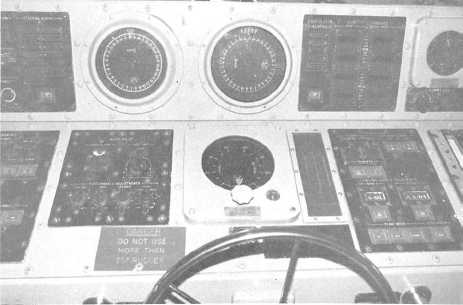| |
Figure 2-12.— DD-963 ship control console.
use aboard ships today. As you can see from these
illustrations, the physical appearance may differ from
ship type to ship type.
Steering Control Console
The steering control console (fig. 2-14) is used in
conjunction with the ship control console. It includes
the rudder angle order indicator-transmitter, helm angle
indicator, ship's course indicator, course-to-steer
indicator, magnetic compass repeater, and emergency
steering switch.
FATHOMETER
Ships are equipped with a sonic fathometer, whose
principle of operation is based upon the fact that sound
travels through water at about 4,800 feet per second.
The fathometer sends out a signal, which bounces off
the ocean floor and returns to the ship much like an
echo. Obviously, half of the time (in seconds) required
for the sound to make the round trip, times 4,800 is the
distance to the bottom, in feet.
The set includes a compact receiver-transmitter unit
in the charthouse, and a transducer on the bottom of the
ship. In spite of its small size, the fathometer gives a
very accurate reading at a wide range of depths, from
about 5 feet to 6,000 fathoms. It is designed for use on
both submarines and surface vessels.
NAVIGATIONAL LIGHTS
LEARNING OBJECTIVE: List and explain the
purpose of the navigation lights aboard ship.
The navigational lights installed on naval vessels
must be in accordance with Navigation Rules,
International-Inland, COMDTINST M16672.2B, or as
allowed by an existing waiver or a waiver to be issued
covering a vessel being built. These lights consist of (1)
running lights, (2) signal lights, and (3) anchor lights.
Figure 2-15 shows navigational lights onboard a vessel
underway.
RUNNING LIGHTS
Running lights of naval ships are similar to those
used on merchant ships. They include the (1) masthead
light, (2) second masthead light (range light), (3) port
and starboard side lights, and (4) stem light (white).
Some of these running lights are illustrated in
figure 2-16.
The masthead light is a white light (fig. 2-16, view
A) located on the foremast or in the forward part of the
ship, between 6 and 12 meters above the deck. It has a
spraytight fixture and is equipped with an inboard
shield to show an unbroken light over an arc of the
horizon of 225°; that is, from right ahead to 22.5° abaft
the beam on either side.
2-10
|

